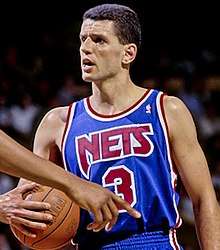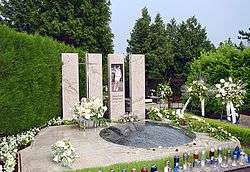Dražen Petrović
Dražen Petrović (pronounced [drǎʒen pětroʋitɕ]; October 22, 1964 – June 7, 1993) was a Croatian professional basketball player. A shooting guard, he initially achieved success playing professional basketball in Europe in the 1980s, before joining the National Basketball Association (NBA) in 1989.
A star on multiple stages, Petrović earned two silver medals and one bronze in Olympic basketball, a gold and a bronze in the FIBA World Cup, a gold and a bronze in the FIBA EuroBasket, and two EuroLeague titles. He represented Yugoslavia's national team and, later, Croatia's national team. He earned four Euroscars, and was named Mr. Europa twice. In 1985, he received the Golden Badge award for best athlete of Yugoslavia.[1]
Seeking a bigger arena after his career start in Europe, Petrović joined the NBA in 1989, as a member of the Portland Trail Blazers. After playing mostly off the bench that year, Petrović experienced a breakthrough following a trade to the New Jersey Nets. While starting for the Nets, he became one of the league's best shooting guards. Petrović's career and life were cut short after he died in a car accident at the age of 28.[2]
Petrović is considered the crucial part of the vanguard to the present-day mass influx of European players into the NBA.[3] Petrović's #3 was retired by the Nets in 1993, and in 2002, he was posthumously enshrined in the Naismith Memorial Basketball Hall of Fame.[4] In 2013, he was voted the best European Basketball player in history, by players at the 2013 FIBA EuroBasket.[5]
Early years
Born in Šibenik, SR Croatia, SFR Yugoslavia, Dražen Petrović was the second child of Jovan "Jole", a police officer, and Biserka (née Mikulandra), a librarian.[3] His father, of Serb ethnicity, was born in Zagora, near Trebinje in Bosnia and Herzegovina.[6][7][8] His mother was born in Bilice, near Šibenik, and was from a traditional conservative Croat family, devoutly Roman Catholic.[9] The couple's eldest child, Aleksandar, would be the first one to tread the basketball path, providing a lead for his younger sibling. The Petrović siblings are second cousins to the Serbian basketball player Dejan Bodiroga.[10][11][12]
Šibenka
At the age of thirteen, Petrović started playing in the youth selections of the local club Šibenka; at the age of fifteen he had already made the first team, just as Šibenka earned a place in the Yugoslav national first division. With young Petrović as the star of the team, Šibenka reached the final of the FIBA Radivoj Korać Cup twice (1981–82 and 1982–83), losing to Limoges CSP both times. In 1983, the 18 year-old Petrović hit two free throws for Šibenka's victory over Bosna in the final playoff game of the Yugoslavian club championship, but the title was taken away from Šibenka the next day by the national basketball federation with irregularities in refereeing cited as the reason, and awarded to Bosna after Šibenka refused to show up for the repeat match.[13]
Rise to European stardom
Cibona
After spending a year serving the mandatory time in the military, Petrović followed his brother's footsteps and moved to Cibona to form, at that time, the best backcourt duo in Europe. The very first year in Cibona he won both the Yugoslav League championship and the Yugoslav National Cup. To top it all off, the 87–78 victory over the Spanish League club Real Madrid, to which Petrović contributed with 36 points, brought him and Cibona their first European Cup title. The second came the following year, as Petrović scored 22 points and Cibona defeated the USSR Premier League club Žalgiris Kaunas, which starred the legendary Arvydas Sabonis. The same year brought another Yugoslav national cup title for Cibona, seeing Petrović score 46 against the old rival Bosna. In 1987, Petrović earned his third European trophy: a 2nd-tier European Cup Winners' Cup title against the Italian League club Scavolini Pesaro, whose net he filled with 28 points.[14]
Petrović's scoring average during the four years with Cibona stood at 37.7 points in the Yugoslavian first division and 33.8 in all of the European wide competitions that he played in, with personal one-time bests of 112 (40/60 FG, 10/20 3Pts, 22/22 FT) in the Yugoslavian League, and 62 points in the 3rd-tier European league, the Korać Cup, respectively.[15] His scoring sheet was often known to show 40, 50, even 60 in a single game; in a 1985–86 season European League game against Limoges, Petrović scored ten 3-pointers, including seven in a row during a first half stretch, for a final tally of 51 points and 10 assists;[16] the same season he scored 45 points and dished out 25 assists against the reigning Italian League champions Simac Milano.[17][18]
Petrović needed new challenges, which Cibona and the Yugoslavian League could not offer. Across the Atlantic, the Portland Trail Blazers of the NBA had already used their third round pick on young Petrović in 1986. However, he decided to postpone his departure to the United States. In 1988, he signed with Real Madrid instead, for at that time a hefty sum of around US$4 million.[19] The transfer wasn't without controversy as the Yugoslav sporting laws stipulated that players weren't allowed to professionally move abroad until reaching 28 years of age, while Petrović was still only 23 when he signed with the famous Madrid club. In 2014, José Antonio Arízaga, the sports agent who played a key role in Petrović's summer 1988 transfer from Cibona to Real, recalled a few details from this transaction: "I spoke to Mirko Novosel, Dražen's coach at Cibona, and he told me two things. One, every problem in Yugoslavia can be taken care of with the right amount of money, and two, if Dražen leaves, every other player under 28 will be leaving and it'll be chaos. So, you can imagine all the individuals I had to bribe and all the places where I had to pay up in order to circumvent this law".[20]
Real Madrid
The 1988–89 season saw Petrović wear the colors of the Spanish ACB League basketball club Real Madrid. Although the Spanish national championship barely escaped them, as they lost to FC Barcelona in the fifth and decisive game of the league's final series, Petrović helped Real to win the Spanish King's Cup title over their Catalan rivals. Petrović also led the club to victory in the 2nd-tier European Cup Winners' Cup final against the Italian League club Snaidero Caserta by tying his previous best scoring performance in European competitions (62 points).[19] His first season in the ACB was also his last, but he still holds ACB single performance bests in a final series game in points made (42) and three-pointers made (8).[15]
Motivated by the challenge and pressured by the Portland Trail Blazers, who had drafted him 60th overall back in 1986, Petrović finally stood firm in the decision to try to establish himself in the NBA. He left Spain rather abruptly at the end of the season; the Blazers assisted in buying out his contract with Real (for as much as US$1.5 million)[21] and Petrović joined the Blazers for the 1989–1990 season.
NBA career
Portland
The Blazers valued Petrović as a shooter, but were concerned that he might not possess the quickness to play guard or the foot speed to play defense. They brought him onto the team primarily as an outside threat to shoot three-pointers. In the Blazers' offensive scheme he was to set up behind the line, receive a passed ball and go directly up to release his shot. Petrović was an aggressive, attacking player who was used to creating his shot and shots for his teammates. Taking the ball out of his hands and making him a static shooter was foreign to him. Making matters worse, the Blazers already had a full rotation of guards, with a starting backcourt of Clyde Drexler and Terry Porter, and with veteran Danny Young as a reserve. Consequently, the reigning La Gazzetta dello Sport Euroscar European Player of the Year saw limited playing time. He had difficulty being productive in the limited role the Blazers had for him. In his rookie year during the 1989–90 NBA season, he averaged 7.4 points in 12 minutes playing time per game.[22] The following season veteran guard Danny Ainge was added to the team, and Petrović's playing time dropped further to 7 minutes a game.[22] In many statements made prior to arriving in Portland, Petrović had said he saw a lack of playing time as the only possible obstacle to his success in the NBA.[19][23] He was determined to be a success in basketball's highest arena. His lack of playing time during his second season in the league brought Petrović's frustration to a climax: "I have nothing to say to Adelman any more and vice versa. Eighteen months have passed by, too long. I have to leave to prove how much I am worth. Never in my life did I sit on the bench and I don’t intent to do that in Portland."[24]
At his insistence, 38 games into the season (20 of which held no playing time for Petrović), a three-way trade with the Denver Nuggets sent him to the New Jersey Nets in exchange for a first-round pick in the following draft and Walter Davis, who was sent from Denver to Portland.[22][25][26]
New Jersey
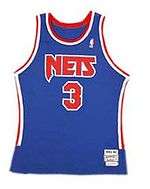
On January 23, 1991, Petrović became a member of the New Jersey Nets. He joined a team that had not reached the playoffs since 1986, but had rookie Derrick Coleman, the number one selection from the 1990 draft. He was immediately given a role on the floor, with 20.5 minutes per game. His scoring over the remaining 43 games increased to 12.6 points per game, one of the league's best points-per-minute ratios. The following year, he and Coleman were joined by Kenny Anderson, giving the team a third talented new addition. Petrović was made a starter for the 1991–92 season, his first full season with the Nets. Petro, as the Americans had dubbed him, did not miss a single game. His determination, hard work and aggressive on court demeanor established him as a team leader. In 36.9 minutes on the floor he averaged 20.6 points. Petrovic led the Nets in field-goal shooting and free-throw shooting, and his field goal percentage of 51% placed him near the top of all NBA guards. More importantly, his success translated into success for the team. The Nets made the playoffs, recording 14 more wins than the previous year. The following season saw Petrović increase his scoring average to 22.3 ppg, 11th best in the league. On December 6, he was named MVP of the Week.[27] For the second season in a row he shot 45% from the three-point arc. His field goal percentage of 52% was again near the top for all guards. American media honored him with a selection to the All-NBA Third Team. However, he did not receive an invitation to the 1993 All-Star game. Among the top 13 scorers in the NBA that season, he was the only one not invited.[28][29]
In an interview on the Scoop B Radio Podcast, Petrovic's Nets teammate, Chucky Brown marveled at Petrovic's healing ability. Brown told Brandon Scoop B Robinson that he remembered Petrovic spraining his knee and was slated to miss two months. Petrovic rehabbed so hard that he ended up only missing two weeks. [30]
NBA career statistics
| Legend | |||||
|---|---|---|---|---|---|
| GP | Games played | GS | Games started | MPG | Minutes per game |
| FG% | Field goal percentage | 3P% | 3-point field goal percentage | FT% | Free throw percentage |
| RPG | Rebounds per game | APG | Assists per game | SPG | Steals per game |
| BPG | Blocks per game | PPG | Points per game | Bold | Career high |
Regular season
| Year | Team | GP | GS | MPG | FG% | 3P% | FT% | RPG | APG | SPG | BPG | PPG |
|---|---|---|---|---|---|---|---|---|---|---|---|---|
| 1989–90 | Portland | 77 | 0 | 12.6 | .485 | .459 | .844 | 1.4 | 1.5 | .3 | .0 | 7.6 |
| 1990–91 | Portland | 18 | 0 | 7.4 | .451 | .167 | .682 | 1.0 | 1.1 | .3 | .0 | 4.4 |
| 1990–91 | New Jersey | 43 | 0 | 20.5 | .500 | .373 | .861 | 2.1 | 1.5 | .9 | .0 | 12.6 |
| 1991–92 | New Jersey | 82 | 82 | 36.9 | .508 | .444 | .808 | 3.1 | 3.1 | 1.3 | .1 | 20.6 |
| 1992–93 | New Jersey | 70 | 67 | 38.0 | .518 | .449 | .870 | 2.7 | 3.5 | 1.3 | .2 | 22.3 |
| Career | 290 | 149 | 26.4 | .506 | .437 | .841 | 2.3 | 2.4 | .9 | .1 | 15.4 |
Playoffs
| Year | Team | GP | GS | MPG | FG% | 3P% | FT% | RPG | APG | SPG | BPG | PPG |
|---|---|---|---|---|---|---|---|---|---|---|---|---|
| 1990 | Portland | 20 | 0 | 12.7 | .440 | .313 | .583 | 1.6 | 1.0 | .3 | .0 | 6.1 |
| 1992 | New Jersey | 4 | 4 | 40.8 | .539 | .333 | .846 | 2.5 | 3.3 | 1.0 | .3 | 24.3 |
| 1993 | New Jersey | 5 | 5 | 38.6 | .455 | .333 | .800 | 1.8 | 1.8 | .4 | .0 | 15.6 |
| Career | 29 | 9 | 21.0 | .474 | .324 | .696 | 1.8 | 1.4 | .4 | .0 | 10.2 |
National team career
Yugoslavia
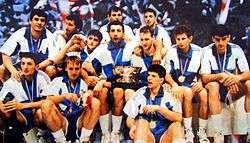
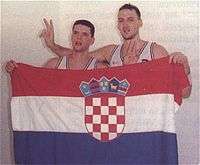
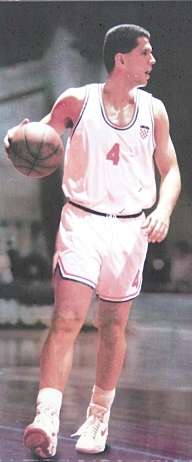
Petrović's national team debut came at the age of 15, at the Under-18 Balkan Championship in Turkey, where the Yugoslavian junior team won the bronze. The young man regularly played for the Yugoslavian national team in the Balkan Championships, also winning gold with the junior team and silver with the senior team. He also brought back the silver from the 1982 FIBA Europe Under-18 Championship in Bulgaria.
The 1984 Summer Olympics were Petrović's first competition of a grand scale with the Yugoslav senior national team, and the bronze medal won in Los Angeles that summer became his first Olympic medal. Third place was also earned at the 1986 FIBA World Championship, remembered for the last minute thriller in the semi-final game against the Soviet Union. At the 1987 EuroBasket, Petrović again returned with bronze, as Yugoslavia lost to the hosts and gold medalists Greece. The University Games, held in Zagreb in 1987, saw the Yugoslavian squad with Petrović win the gold. In the 1988 Summer Olympics, Yugoslavia with Petrović, earned 2nd place, as they lost once more to the Soviet powerhouse.[14]
An excellent club season with Real Madrid was topped by Petrović's 1989 accomplishment with the Yugoslav national team: at the EuroBasket in Zagreb, the young Yugoslavian team went all the way, defeating Greece more than comfortably in the championship game. Petrović was the tournament's second leading scorer and most valuable player. The very next year, the summer in between the two most frustrating seasons of his professional career, as he struggled for playing time with the Trail Blazers, Petrović was again making history with the national team, as Yugoslavia became world champions, after beating the Soviet Union for the gold in Buenos Aires, at the 1990 FIBA World Championship.[31]
Croatia
The 1992 Olympic Games in Barcelona, marked the first summer Olympics featuring the independent Croatia, and Petrović was the leader of the Croatian national basketball team at the Olympic basketball tournament. Losing only to the American Dream Team in group stage, a strong and inspired Croatian team emerged victorious from the Semifinals against the revamped Soviet team, thanks to clutch free throws executed by Petrović, and faced off against the Americans for the gold. Urged on by Petrović's competitiveness and confidence,[3] the Croatians fared well in the first ten minutes of the game, taking a 25–23 lead on a Franjo Arapović dunk and the subsequent free throw.[32] As the game progressed, however, the now-legendary team composed of NBA stars proved too tough for Croatia: the Americans won 117–85, sending Petrović, the game's leading scorer with 24 points, and his teammates, home with silver medals.[3][33]
In the period during which Petrović played for the Croatian national team (from 1992 to 1993), he appeared in 40 games and scored 1,002 points. His highest point tally came against Estonia, on 31 May 1993 (48 points).[34]
Death and legacy
In the summer of 1993, after his best NBA season and the Nets' first-round elimination by the Cleveland Cavaliers, Petrović traveled to Berlin, where the Croatian national team was playing a qualification tournament for the 1993 EuroBasket. He was contemplating departure from the Nets, disappointed with tension between himself, and in his belief, envious teammates, as well as the fact that the Nets had not yet extended his contract. He told American reporters that the lack of recognition in the league had him also considering leaving the NBA completely and playing club basketball in Greece; there were at least two Greek clubs ready to offer Petrović three-year contracts worth US$7.5 million net.[26] It was rumored that Petrović verbally agreed on terms with Panathinaikos; these rumors gave rise to the story of PAO's owner, Pavlos Giannakopoulos, allegedly offering the Nets' star a signed contract with blank salary terms, which became a part of Petrović's legend. Petrović decided to skip the connection flight back to Zagreb and drive with his girlfriend back to Croatia.
Petrović died in a traffic accident at approximately 17:20 on Monday, June 7, 1993, four and a half months before his 29th birthday. On the rain-drenched Autobahn 9, he was a passenger in a car that was cut off by a semi truck at Denkendorf, near Ingolstadt, in the German state of Bavaria. According to the report of the Ingolstadt police, that afternoon a truck broke through the Autobahn median; the truck driver was trying to avoid a collision with a personal vehicle in his own lane and lost control of the truck, crashing through the median barrier and finally coming to a stop blocking all three lanes of traffic in the opposite direction (Munich). Seconds later, the VW Golf carrying a sleeping Petrović in the passenger seat crashed into the truck, killing him and leaving the driver, Klara Szalantzy, a Hungarian model and basketball player with whom Petrović was romantically involved, and Hilal Edebal, a female Turkish basketball player, with grave injuries.[26][35] It was established that visibility on the road was very poor and that Petrović was not buckled with a seatbelt.[3]
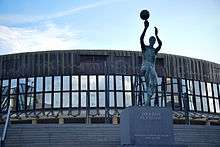
Petrović's tomb 45°50′22″N 15°59′00″E / 45.83947°N 15.98328°E at Mirogoj Cemetery instantly became a sanctuary for his compatriots. The Cibona stadium was renamed the Dražen Petrović Basketball Hall on October 4, 1993, and the city of Zagreb dedicated a square in his name, which was later followed by Šibenik and Vukovar, while Petrinja dedicated him a street. The Nets retired his number 3 jersey on November 11, 1993. After 1994, the MVP award at the McDonald's Championship had borne the name Dražen Petrović Trophy, and the Croatian Olympic Committee's award for young athletes has borne his name since 2006. On April 29, 1995, a statue commemorating Petrović's significance to the world of sports was erected in front of the Olympic Museum in Lausanne, Switzerland, thus making him only the second athlete to receive this honor. On July 9, 2001, having defeated Patrick Rafter to win the men's singles title at Wimbledon, Croatian tennis player Goran Ivanišević dedicated the win to his late friend Petrović;[36] Ivanišević wore Petrović's Nets jersey amidst the 100,000 strong crowd celebrating his victory in Split.[3] Petrović was inducted posthumously into the Basketball Hall of Fame in 2002. In 2006, the 13th anniversary of Petrović's death was marked with the opening of the Dražen Petrović Memorial Center in Zagreb, dedicated to his life and achievements, with ten themed galleries of multimedia content outlining his entire career and a four meter high statue of Dražen in shooting position in front of it. Petrović was enshrined in the FIBA Hall of Fame in 2007.[37]
The 2010 documentary, Once Brothers (part of the ESPN 30 for 30 series), portrays the achievements of the Yugoslavia national basketball team in the late 1980s and early 1990s, and how the Yugoslav Wars tore the team apart. It explores Petrović's broken friendship with Serbian/Yugoslav player Vlade Divac. In 2011, a statue of him as a little boy sitting on a bench with a ball was unveiled in Šibenik, and his old room was renovated the way it looked when he was young, as a first part of opening a Memorial Center in his hometown. During the 2012 Three Point Shootout, New Jersey Nets guard Anthony Morrow wore Petrović's jersey in the latter's honor. In 2015, Australian writer Todd Spehr released a 470-page biography on Petrović, Dražen: The Remarkable Life & Legacy of the Mozart of Basketball. On June 3, 2015. Croatian basketball journalists Marjan Crnogaj and Vlado Radicevic released a 487-page (462 footnote) unofficial biography [38] which global paperback edition (472 pages, 679 footnotes, 50 photos) was released on October 14, 2017.[39]
Reactions
| “ | It's hard for you to imagine here in America, because you have so many great players, but we are a country of four million; without him, basketball takes three steps back. | ” |
| — Aleksandar "Aco" Petrović[21] | ||
| “ | You know, there is a saying that we have about JFK, John F. Kennedy – "You know, Johnny, we never got to know you." And I kind of feel that way about Dražen. I felt that the whole year that I was with him went by too fast and I really never got to know him the way I would have liked to. | ” |
| — Chuck Daly[40] | ||
| “ | Dražen and I were very good friends. I was one of those people who welcomed him to Portland when he came from Europe. We talked about his family a lot in his restaurant, and he enjoyed his friends and he enjoyed the game of basketball. I really respect him because he worked very, very hard. Each and every day in practice he would be the first guy to come and the last guy to leave the gym. So anybody with that kind of dedication...you have to have a lot of respect for him. | ” |
| — Clyde Drexler[40] | ||
| “ | Dražen Petrović was an extraordinary young man, and a true pioneer in the global sports of basketball. I know that a lasting part of his athletic legacy will be that he paved the way for other international players to compete successfully in the NBA. His contributions to the sport of basketball were enormous. We are all proud of the fact we knew him. | ” |
| — David Stern[41] | ||
| “ | It was a thrill to play against Dražen. Every time we competed, he competed with an aggressive attitude. He wasn't nervous; he came at me as hard as I came at him. So, we've had some great battles in the past and unfortunately, they were short battles. | ” |
| — Michael Jordan[41] | ||
Accomplishments and awards
Club competitions
| Year | Competition | Achievement | Club |
|---|---|---|---|
| 1982 | Korać Cup (3rd-tier European League) | Finalist | Šibenka |
| 1983 | Korać Cup (3rd-tier European League) | Finalist | Šibenka |
| 1985 | European Champions Cup (EuroLeague) (1st-tier European League) | Winner | Cibona |
| 1985 | Yugoslavian Championship | Winner | Cibona |
| 1985 | Yugoslavian Cup | Winner | Cibona |
| 1986 | European Champions Cup (EuroLeague) (1st-tier European League) | Winner | Cibona |
| 1986 | Yugoslavian Championship | Finalist | Cibona |
| 1986 | Yugoslavian Cup | Winner | Cibona |
| 1987 | European Cup Winners' Cup (2nd-tier European League) | Winner | Cibona |
| 1988 | Yugoslavian Cup | Winner | Cibona |
| 1988 | Korać Cup (3rd-tier European League) | Finalist | Cibona |
| 1989 | Spanish Cup | Winner | Real Madrid |
| 1989 | Spanish Championship | Finalist | Real Madrid |
| 1989 | European Cup Winners' Cup (2nd-tier European League) | Winner | Real Madrid |
| 1990 | NBA Playoffs | Finalist | Portland Trail Blazers |
- Yugoslav First League: most points scored by an individual, in a league game (112).
- Spanish ACB League: most points scored by an individual, in a final series game (42).[15]
- Spanish ACB League: most 3 point field goals made by an individual, in a final series game (8).[15]
- NBA: 1991–92 season's second highest 3 point field goal percentage (.444).[22]
- NBA: 1991–92 season's fourth highest field goal percentage among guards (.508).
- NBA: 1992–93 season's second highest 3 point field goal percentage (.449).[22]
- NBA: 1992–93 season's second highest field goal percentage among guards (.518).[42]
- NBA: third best career 3 point field goal percentage (.437).[22]
National teams
| Year | Event | Host | Placement | Country |
|---|---|---|---|---|
| 1980 | Balkan Championship for Junior Men | Istanbul, Turkey | Yugoslavia | |
| 1981 | Balkan Championship for Cadets | Thessaloniki, Greece | Yugoslavia | |
| 1982 | Balkan Championship for Junior Men | Patras, Greece | Yugoslavia | |
| 1982 | FIBA Europe Under-18 Championship | Dimitrovgrad and Haskovo, Bulgaria | Yugoslavia | |
| 1983 | University Games | Edmonton, Canada | Yugoslavia | |
| 1984 | Balkan Championship | Athens, Greece | Yugoslavia | |
| 1984 | Summer Olympic Games | Los Angeles, United States | Yugoslavia | |
| 1986 | FIBA World Championship | Madrid, Spain | Yugoslavia | |
| 1987 | University Games | Zagreb, Yugoslavia | Yugoslavia | |
| 1987 | FIBA EuroBasket | Athens, Greece | Yugoslavia | |
| 1988 | Summer Olympic Games | Seoul, South Korea | Yugoslavia | |
| 1989 | FIBA EuroBasket | Zagreb, Yugoslavia | Yugoslavia | |
| 1990 | FIBA World Championship | Buenos Aires, Argentina | Yugoslavia | |
| 1992 | Summer Olympic Games | Barcelona, Spain | Croatia | |
- Balkan Championship for Junior Men Best Player: (1982)
- FIBA World Cup MVP: (1986)[18]
- FIBA EuroBasket MVP: (1989)
Dražen Petrović Memorial Center
A museum named "The Dražen Petrović Memorial Center" was founded in his honor, and constitutes a co-operative effort led by the Dražen Petrović Foundation in conjunction with the Croatian government, the city of Zagreb and the Croatian Museum of Sports. The memorial center idea originated from Petrović's parents, Biserka and Jole Petrovic, and was supported with the contributions of Croatian architects Andrija Rusan and Niksa Bilic. All of the articles presented in the center have been collected and categorized by the Croatian Museum of Sports. The organization and operations of the center have been provided by the Dražen Petrović Foundation, which is led by Petrović's family. The Center contains his No. 3 New Jersey Nets jersey and the watch that stopped when he died in a car crash. The center features 1,000 memorabilia items and a video of his basketball highlights.[43]
The official opening of the museum was held on June 7, 2006, while the official opening of the center to the public began at the end of December 2006. The square on which the center is operated upon has been renamed to Dražen Petrović Square in his honor.[44] In 2013, former NBA MVP Derrick Rose visited the museum.[45]
See also
References
- ↑ "Novak Đoković dobitnik "Sportove" zlatne značke; Dobitnici zlatne značke". DSL Sport. Archived from the original on 26 January 2016. Retrieved 9 January 2016.
- ↑ SI.com The tragic death of Drazen Petrovic
- 1 2 3 4 5 6 Rodrick, Stephen. "Spirit of the Game". August 8 issue of ESPN The Magazine. Archived from the original on March 13, 2007.
- ↑ NBA.com, Drazen Petrovic
- ↑ CroatiaWeek.com The Best European Basketballer Ever
- ↑ "A World Apart, Nets' Petrovic Is Mourned: In New Jersey and the former Yugoslavia, 28-year-old guard is remembered after being killed in car crash". Los Angeles Times. 9 June 1993. Retrieved 30 June 2013.
His father was a Serb and his mother a Croat, and he competed for Croatia
- ↑ Dušan Čolović (15 August 1990). "Igraću samo za Jugoslaviju!". Tempo (1277).
- ↑ "Prisoners of War". Sports Illustrated, 1996 Olympics.
Petrovic, whose father is a Serb
- ↑ Dmitrović, Ratko (October 1, 2010). "Praznina u duši Vlade Divca".
- ↑ Bodiroga, Dejan (May 2013). "An Interview with Dejan Bodiroga". Agape (Interview). Interviewed by Aleksandar Gajšek. Belgrade: Studio B.
- ↑ A., L. (16 August 2013). "Evo dokaza: Dražen Petrović i Bodiroga su bliski rođaci!" [Here's a Proof: Dražen Petrović and Bodiroga Are Close Relatives] (in Croatian). Retrieved 3 September 2017.
- ↑ Dejan Bodiroga Official Site Archived March 26, 2012, at the Wayback Machine.: "Legendarni košarkaš Dražen Petrović, prvo reprezentativac Jugoslavije pa zatim Hrvatske, bio je rođak Dejana Bodiroge. Naime, Dejanova baba po ocu i Draženov deda po ocu jesu rođeni brat i sestra. Dražen, čiji je rođeni brat košarkaški trener Aleksandar Petrović (takođe bio reprezentativac Jugoslavije), poginuo je u saobraćajnoj nesreći u Nemačkoj 1993. Uvršten je u Najsmitovu Kuću slavnih u Springfildu."
- ↑ Sibenik.hr, Drazen Petrović profile Archived October 16, 2007, at the Wayback Machine., sibenik.hr; accessed 19 August 2015.
- 1 2 "Chronology". DrazenPetrovic.com. Retrieved 15 August 2013.
- 1 2 3 4 "Statistics". drazenpetrovic.com. Retrieved 24 March 2014.
- ↑ DrazenPetrovic.com, Cibona: Moment in time...
- ↑ DrazenPetrovic.com, Cibona Story
- 1 2 24sec.net, Hall of Fame Archived October 19, 2007, at the Wayback Machine., drazenpetrovic.com; accessed 19 August 2015.
- 1 2 3 Real Madrid Story, drazenpetrovic.com; accessed 19 August 2015.
- ↑ Alejandro Delmás (10 October 2014). "Dražen Petrović vino a España a base de sobornar y corromper". As (in Spanish). Retrieved 13 October 2014.
- 1 2 NBA.com, Dražen Petrović legacy Archived April 12, 2006, at the Wayback Machine., drazenpetrovic.html; accessed 19 August 2015.
- 1 2 3 4 5 6 Basketball-Reference.com, Drazen Petrovic
- ↑ DrazenPetrovic.com, Blazers Portland Story
- ↑ DrazenPetrovic.com, Memories of Drazen Petrovic
- ↑ Hoopsanalyst.com, Best Trades in History: Atlantic Division
- 1 2 3 Mike Freeman, Details Emerge, but Petrovic's Death Still Baffles, The New York Times, June 9, 1993
- ↑ "1992-93 NBA Season Summary".
- ↑ NBA.com, League Leaders: Points - 1992-93
- ↑ NBA.com, 1993 All-Star Game Boxscore: West 135, East 132 (OT)
- ↑ "Former NBA player recalls Nets' Drazen Petrovic spraining knee & missing a few games rather than a few months". Basketball Society. Retrieved May 14, 2018.
- ↑ USABasketball.com, Eleventh World Championship Archived April 28, 2007, at the Wayback Machine.
- ↑ "Revisiting USA-Croatia 1992 (or, Why YouTube is God, part 1 of many)". BallinEurope. 25 January 2010. Archived from the original on 17 November 2011. Retrieved 2 April 2012.
- ↑ DrazenPetrovic.com, Nets New Jersey Story
- ↑ Dražen Petrović Stats Archived October 21, 2007, at the Wayback Machine., cibona.com; accessed 19 August 2015. (in Croatian)
- ↑ HRT.hr, Today in History - July 7th (in Croatian) Archived 2006-12-10 at the Wayback Machine.
- ↑ Ivanišević honours late NBA star, cbc.ca; accessed 19 August 2015.
- ↑ FIBA.com, FIBA Hall of Fame Profile Archived 2007-09-30 at the Wayback Machine.
- ↑ http://www.netsdaily.com/2015/5/30/8691221/new-book-drazen-petrovic-planned-on-european-return-then-free-agency
- ↑ https://www.amazon.com/Dra%C5%BEen-Years-Dragon-untold-story/dp/9535974114/ref=sr_1_5?ie=UTF8&qid=1508497768&sr=8-5&keywords=drazen+petrovic
- 1 2 DrazenPetrovic.com, Memories of Drazen Petrovic
- 1 2 DrazenPetrovic.com, Home Page
- ↑ BasketballReference.com, 1992-93 NBA Player Register Archived 2007-10-17 at the Wayback Machine.
- ↑ "MIGHTY QUINN – Sports". NY Daily News. New York. June 11, 2006. Archived from the original on December 10, 2007.
- ↑ Hawkesworth, Celia. (2007). Zagreb: a cultural and literary history, Signal Books. ISBN 1-904955-30-4, ISBN 978-1-904955-30-6, page 188. https://books.google.com/books?id=eBSxMUKFJDEC&printsec=frontcover#v=onepage&q=&f=false
- ↑ "Derrick Rose Visits Croatia (photos)". Slam. July 10, 2013. Retrieved May 30, 2016.
Sources
- Freeman, Mike (June 9, 1993). "Details Emerge, but Petrovic's Death Still Baffles". The New York Times.
- Huber, Jim (January 12, 2006). "Drazen Petrovic". Inside the NBA.
- Hawkesworth, Celia (2007). Zagreb: a cultural and literary history. Signal Books.
External links
| Wikimedia Commons has media related to Dražen Petrović. |
- Drazen Petrovic Museum
- Drazen Petrovic Unofficial Web Site
- Career statistics and player information from Basketball-Reference.com
- Drazen Petrovic Yugoslavia FIBA Profile
- Drazen Petrovic Croatia FIBA Profile
- FIBA Europe Profile
- Drazen Petrovic at the Basketball Hall of Fame
- Euroleague.net 50 greatest contributors
- In Honor of Dražen Petrović
- FIBA Hall of Fame profile
- Dražen Petrović Player Profile (InterBasket)
- Dražen Petrović at Find a Grave
- Drazen: The Remarkable Life & Legacy of the Mozart of Basketball (book)
